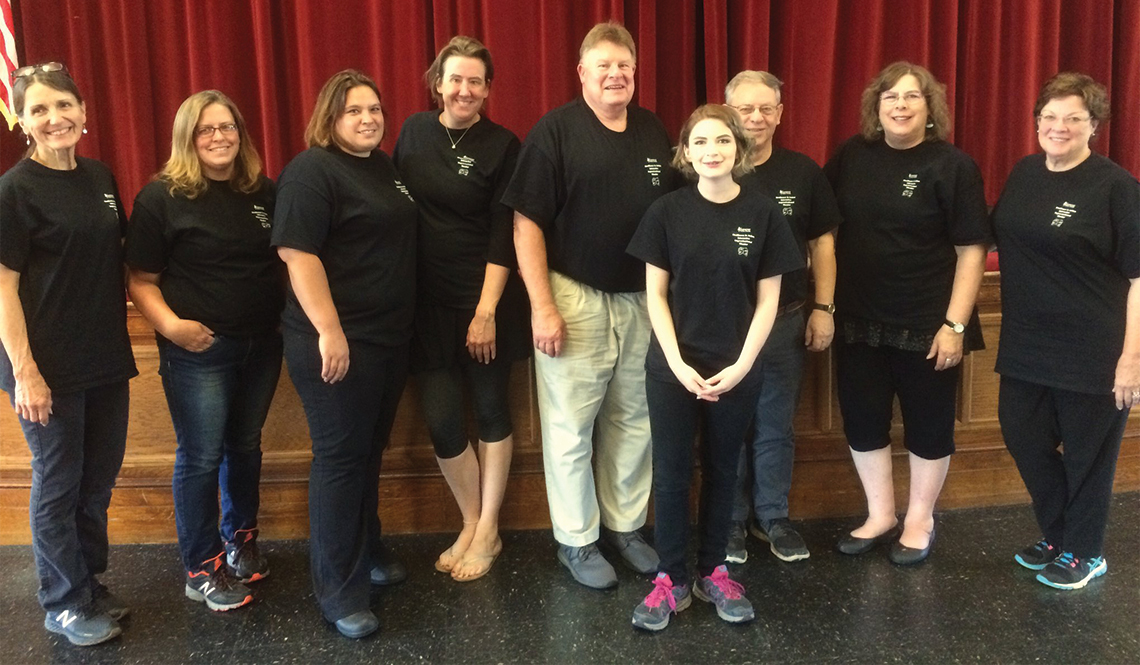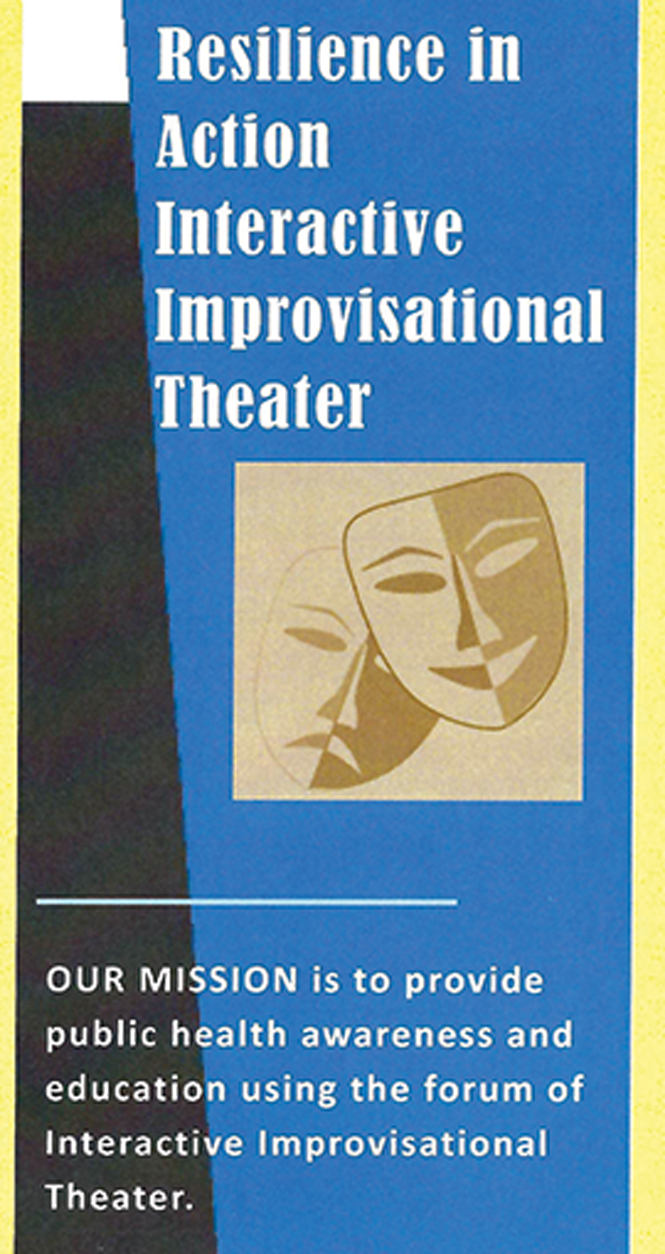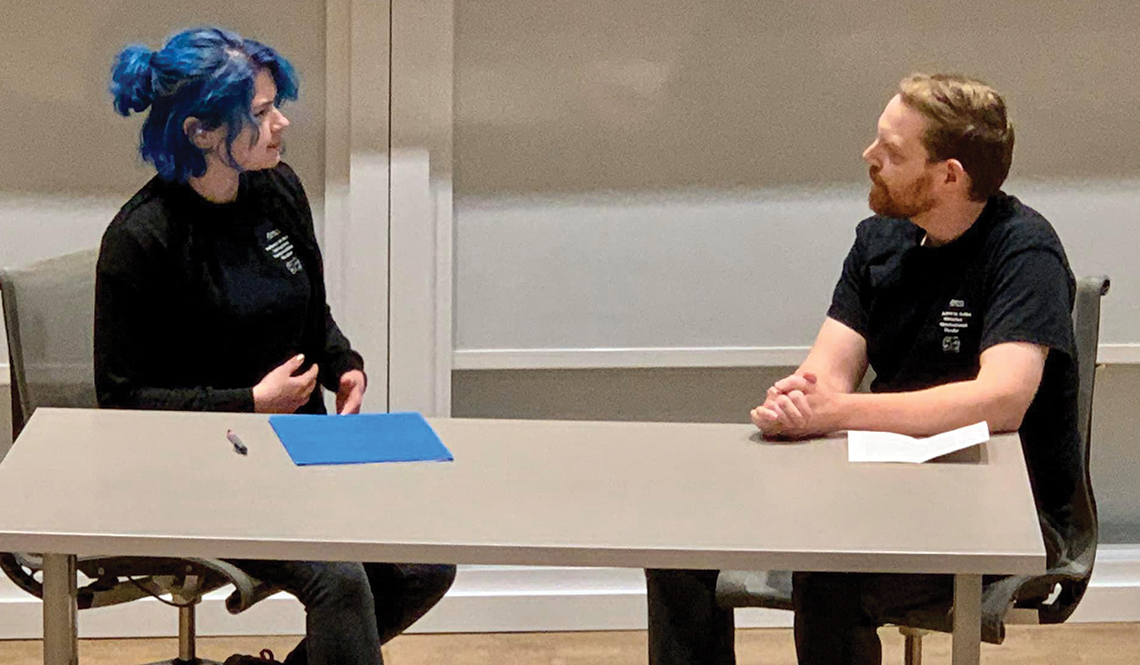Using Improv Theater to Build Resilience and Improve Livability
Interactive performances are a time-tested tool for change. It may be time for a post-COVID comeback
A major challenge for livability initiatives is how to help community members connect despite their differences of (to name just a few characteristics) age, race, religion, ethnicity, education, income, health, household composition, length of residency, political views and lifestyle. Interactive, improvisational theater — in which performers act out real-life scenarios and then enlist the audience's help in finding solutions — is a time-tested tool for resolving conflicts, facilitating change and building resilience.
In June 2019, shortly before COVID-19 put the kibosh on non-virtual gatherings, this technique took center stage at the AARP Livable Communities Rural Livability Workshop. During a session on community engagement, two actors from the Somerset County, Maine-based Resilience in Action Interactive Improvisational Theater troupe dramatized a challenge that the opioid crisis has made all too common among older Americans: raising grandchildren whose drug-addicted parents can’t care for them.
The performers, both in their 60s, were introduced to the audience by a facilitator, who explained that they would portray a couple suddenly responsible for three small children. As the scene opens, the grandfather is sorting through the household bills; the grandmother joins him at the kitchen table, having just put the kids to bed.
Through their dialogue, it emerges that the man is working two jobs but can barely support their expanded family. The woman is stuck at home, unable to socialize with friends enjoying the freedom of an empty nest, or with the young mothers at the playground. Both feel judged by acquaintances who blame them for their daughter’s addiction. They are sick of eating spaghetti every night to cut costs — and terrified that if they fall behind on the utilities, county authorities will take away the children.
"Something’s got to give," the man exclaims. "Or else!"
The facilitator, who was standing off to the side, clicked two wooden batons together, making a loud noise to end the vignette. He invited the audience to ask questions of the couple. Swept up in the spirit of the performance, attendees probed the characters about their emotional state and practical needs, offering advice that included information about local agencies that could help. After about 10 minutes of conversation and brainstorming between the actors and the audience, as well as among audience members, the facilitator introduced the actors by their real names, breaking the spell and unleashing a tempest of applause.
"Community theater isn’t uncommon," says Melissa Stanton, a senior advisor and editor at AARP Livable Communities, who was among those clapping. "But this is theater for building community. It helps people understand what their neighbors are experiencing, and get past reactions like, 'If only you’d done this or avoided that.' It can turn 'us versus them' into a larger sense of 'us.'"
Patricia Oh, an age-friendly communities consultant for AARP Maine, was also in the audience. "By engaging in conversation with the characters, audiences can open their minds to issues that might have seemed too scary to talk about with each other," she says. "Sometimes the lights go on."
Lately, though, improv-for-community-change troupes have faced challenges of their own.
An Endangered Art Form
A few decades ago, dozens of troupes like Resilience in Action plied their empathy-enhancing skills across the country. The idea of using theater to address social conflicts first emerged in the 1940s, with a technique called "sociodrama." But the practice really took off during the upheavals of the Vietnam War era.
The efforts went by a variety of names, including social action theater, guerrilla theater, exploratory theater and Theater of the Oppressed. What they all had in common was a focus on breaking down the barriers between performers and audience, with the aim of generating insights that could help heal society’s ills.
The method showcased at the AARP Rural Livability Workshop made its debut in 1973, when the Family Life Division of New York Medical College launched a program in which kids from local high schools presented scenes from their world.
"If you do it right, it's not like watching a performance. The idea is to get people to buy into the scenario — to become so engaged that they're willing to work on solving the problem you’ve presented."
— Bob Mcintire, actor and chair of Age-Friendly Hallowell
The acting troupe explored topics ranging from drugs and alcohol to health and developmental issues. And it introduced an innovation meant to heighten a performance’s impact: a Q&A session in which the actors stayed in character while dialoguing with the audience.
In Skowhegan, Maine, a former off-Broadway actress named Marti Stevens started an improv theater program for teens based on the Family Life Division model. Excited by the results, Stevens — who’d also founded a literacy program for grownups — introduced the technique at a regional conference of adult educators in 1984.
That inspired some attendees to adopt the model for their own communities, and to spread it further. They formed the Northern New England Social Action Theater, which staged performances and trainings from coast to coast. By the late 1990s, when a 68-page manual titled Literacy Theatre was published, the movement was thriving. State officials in Maine and New Hampshire incorporated its methods into adult-education curricula.
Back in Skowhegan, Stevens founded an adult troupe called the Maine Literacy Awareness Theater. After her death in 1993, the nonprofit renamed itself the Marti Stevens Interactive Improvisational Theater (MSIIT) and grew into one of the most successful enterprises of its kind. MSIIT moved to Augusta, Maine’s state capital, and expanded its mission far beyond literacy — performing for state agencies, corporations, schools, hospitals, family crisis centers, correctional facilities and other clients, on topics including domestic abuse, sexual harassment, cultural diversity and gender-identity bias.
"What makes this method effective is that we’re not just talking heads," explains MSIIT executive director Susan Parks, who joined the troupe more than 30 years ago. "We're touching on the gut, the heart and the mind. This model goes deep quickly, and the end products are ideas and solutions."
Still, the company — like others with roots in literacy theater — has faced strong headwinds since the turn of the millennium.
"What makes this method effective is that we're not just talking heads. We're touching on the gut, the heart and the mind. This model goes deep quickly, and the end products are ideas and solutions."
— Susan Parks, executive director, Marti Stevens Interactive Improvisational Theater
First came federal legislation that slashed funding for state and local adult-ed programs. Soon afterward, the Great Recession gutted corporate training budgets. By the 2010s, MSIIT was one of the few remaining troupes that specialized in the genre. And then COVID-19 hit.
MSIIT has been on hiatus since January 2020. "What we do can’t be done online," Parks says. "That's not how it works."
Tackling a Wide Range of Problems
Resilience in Action Interactive Improvisational Theater, the group that performed at the AARP workshop, has been in limbo as well. But its story helps illustrate why this type of production is worthy of a revival.
The troupe's founder, Bill Primmerman, discovered interactive improv in the mid-'80s, when he taught with Marti Stevens and became an adult member of her teen theater project. Primmerman later became the director of the school health program at the Maine Department of Education, where Susan Parks also worked. He often used interactive theater troupes at the state's high schools to raise awareness about adolescent health issues.
After moving to a leadership position at Somerset Public Health, a community-health coalition based in Skowhegan, the seat of Somerset County, he realized that the technique could also be valuable for addressing broader challenges facing the area's older, largely low-income population.
But it was only as a freshly minted retiree that Primmerman (who continued working part-time at Somerset Public Health) found a way to realize that vision.
In 2017, Somerset Public Health won a $44,692 grant from the Maine-based Bingham Foundation Community Health Program enabling it to launch an interactive theater project.
The stated purpose was to explore the impact of adverse childhood experiences, or ACEs — a term used by health experts for troubles stemming from homelessness, domestic violence, neglect, addiction, sexual or physical abuse, and other issues — in a way that "involves and assists the audience in recognizing those issues and strategizing solutions." Locals of all ages were recruited as players. MSIIT was hired to train the troupe and its leaders, and to develop scenarios based on community concerns.
As the project got underway, however, residents made it clear that childhood traumas weren’t the only matters that needed addressing.
"The vehicle of interactive theater is flexible enough to be utilized wherever people have an issue."
— Bill Primmerman, founder, Resilience in Action Interactive Improvisational Theater
The acronym ACEs also applies to adverse community environments, such as inadequate housing, discrimination, poverty, violence and a lack of opportunity. In that ACEs category, challenges facing older people ranked high on the list of locals’ concerns. (Considered together, adverse childhood and community experiences are referred to as a "pair of ACEs.")
At the same time, Primmerman was helping to facilitate the work being done in Skowhegan and nearby Jackman and Madison as part of each community's enrollment in the AARP Network of Age-Friendly States and Communities. He invited volunteers from those towns (and, eventually, from three other counties) to receive training as well.
"The vehicle of interactive theater is flexible enough to be utilized wherever people have an issue," Primmerman explains. With MSIIT's help, the 12-member Resilience in Action troupe created vignettes on aging-related issues such as food insecurity, losing the ability to drive safely, and grandparents raising grandchildren.
Although such performances carry an air of informality, their effectiveness depends on careful planning and strict guidelines. Training was led by Parks and several members of her company — including Bob Mcintire, another Maine Department of Education veteran (and chair of Age-Friendly Hallowell), who has acted with MSIIT for a dozen years.
"If you do it right," Mcintire says, "it's not like watching a performance. The idea is to get people to buy into the scenario — to become so engaged that they're willing to work on solving the problem you’ve presented."
To make that happen, the performers must follow certain rules. Among them:
- Keep it short: Scenarios should run three minutes or less
- Know your audience: The troupe does advance research to tailor its performances for maximum impact
- Use simple sets and real props: Audiences shouldn't be distracted by fancy staging
- Force the audience to feel: Speak plainly, and never play for laughs
- Present unresolved conflict: Tension should build to the snapping point, signified by a predetermined "cut line" — as when the overburdened grandfather bursts out, "Something’s got to give!" At that juncture, the facilitator stops the action and invites the audience to interact with the characters.
Another essential element of the performance is to provide support for audience members who need help for the kind of problem being portrayed, or who are emotionally triggered by what they see onstage.
"By engaging in conversation with the characters, audiences can open their minds to issues that might have seemed too scary to talk about with each other."
— Patricia Oh, age-friendly consultant
"You don't do this without a safety net," says Primmerman. "We had handouts on a table with relevant resources, and we made sure there were people in the room to talk to if someone wanted to continue the discussion."
Post-show feedback is important, too — and not just in the form of cheers or boos. After each presentation, the troupe passed out questionnaires, using a five-point scale, to gauge whether the show deepened audience members’ understanding of the issues discussed.
In December 2019, after Resilience in Action's first batch of performances, Primmerman presented a preliminary assessment to the Bingham Foundation. "Self-reported knowledge/understanding increased for all groups of respondents," he wrote. "The overwhelming preponderance of responses were positive, with respondents saying the presentations were positive, powerful, thought-provoking, informative, engaging, realistic, and definitely recommended to friends and colleagues."
Soon afterward, however, the global COVID-19 pandemic brought the troupe’s work to a halt.
Hoping for a Revival
More than a year later, there are no plans to resurrect Resilience in Action.
“Our central missions are preventing substance abuse and promoting physical activity and good nutrition,” explains Matt L’Italien, director of Somerset Public Health. "The program would probably be a better fit for a behavioral health organization that works with older adults, or an Area Agency on Aging, if they had programmatic money to work on the social determinants of health.”
Still, he adds, “We're keeping our eyes open for opportunities to pass the reins to another player, if we can find the right one.” Should that happen, says Primmerman, “I don’t want be the lead person, but my wife and I would consider being part of the troupe.”
Susan Parks, for her part, doesn't pretend to be certain about the future of MSIIT.
"The pandemic has defeated a lot of worthy groups, unfortunately," says Parks. Yet she remains optimistic. Maine has one of the highest vaccination rates in the United States, and case rates (despite a recent uptick) are a fraction of their 2020 peaks. Live performance is feasible again. A workplace safety training for a Portland corporate group, originally scheduled for the spring of 2020, has been tentatively rescheduled for this fall.
Once COVID passes, prospects for the kind of theater that Marti Stevens pioneered could be stronger than they’ve been in years.
At a time of intense polarization, efforts to foster empathy and problem-solving on a community level seem particularly relevant. And such theatrical projects — though interrupted by the virus — have never really gone away. In Europe, a nonprofit called AgeingEqual has been using interactive improv to raise awareness of elder abuse. At U.S. colleges, student organizations have used it to combat racism, homophobia and sexual assault. At migrant camps in Virginia, a legal-aid group has employed it to help agricultural workers learn their rights.
"The approach that we use is powerful," Parks says. "It gets the audience excited and a little agitated. After we leave, their minds are working. I don’t think there's a better way to get people to talk about topics that are hard to discuss."
Kenneth Miller is an award-winning writer and editor based in Los Angeles. His work has appeared in Time, Life, Esquire, Rolling Stone, Discover, Mother Jones, Salon, Reader’s Digest, Parade, Prevention, Los Angeles Times Magazine and many other publications.
Page published August 2021
Resilience Defined
Excerpted from materials shared by the Resilience in Action Interactive Improvisational Theater
- Resilience is the ability to work with adversity in such a way that one comes through it unharmed or even better for the experience.
- Resilience means facing life's difficulties with courage and patience — refusing to give up. It is the quality of character that allows a person or group of people to rebound from misfortune, hardship and trauma.
- Resilience is rooted in a tenacity of spirit, a determination to embrace all that makes life worth living even in the face of overwhelming odds. When we have a clear sense of identity and purpose, we are more resilient, because we can hold fast to our vision of a better future.
Much of our resilience comes from community — from the relationships that allow us to lean on each other for support when we need it.
Learn More
- Visit AARP Maine
- See the AARP Network of Age-Friendly States and Communities Member List
- Find resources about Community Engagement
AARP.org/Livable
Or visit the A-Z Archive at top






